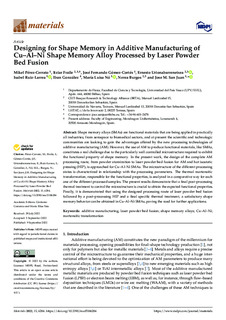Izenburua
Designing for Shape Memory in Additive Manufacturing of Cu–Al–Ni Shape Memory Alloy Processed by Laser Powder Bed FusionEgilea
Egilea (beste erakunde batekoa)
Beste instituzio
Universidad del País Vasco/Euskal Herriko Unibertsitatea (UPV/EHU)Centro de Estudios e Investigaciones Técnicas de Gipuzkoa (CEIT)
Tecnun
Bertsioa
Bertsio argitaratua
Eskubideak
© 2022 The AuthorsSarbidea
Sarbide irekiaArgitaratzailearen bertsioa
https://doi.org/10.3390/ma15186284Non argitaratua
Materials Vol. 15. Nº 18. September, 2022Argitaratzailea
MDPIGako-hitzak
additive manufacturing
laser powder bed fusion
shape memory alloys
Cu–Al–Ni ... [+]
laser powder bed fusion
shape memory alloys
Cu–Al–Ni ... [+]
additive manufacturing
laser powder bed fusion
shape memory alloys
Cu–Al–Ni
martensitic transformation [-]
laser powder bed fusion
shape memory alloys
Cu–Al–Ni
martensitic transformation [-]
Laburpena
Shape memory alloys (SMAs) are functional materials that are being applied in practically all industries, from aerospace to biomedical sectors, and at present the scientific and technologic communitie ... [+]
Shape memory alloys (SMAs) are functional materials that are being applied in practically all industries, from aerospace to biomedical sectors, and at present the scientific and technologic communities are looking to gain the advantages offered by the new processing technologies of additive manufacturing (AM). However, the use of AM to produce functional materials, like SMAs, constitutes a real challenge due to the particularly well controlled microstructure required to exhibit the functional property of shape memory. In the present work, the design of the complete AM processing route, from powder atomization to laser powder bed fusion for AM and hot isostatic pressing (HIP), is approached for Cu–Al–Ni SMAs. The microstructure of the different processing states is characterized in relationship with the processing parameters. The thermal martensitic transformation, responsible for the functional properties, is analyzed in a comparative way for each one of the different processed samples. The present results demonstrate that a final post–processing thermal treatment to control the microstructure is crucial to obtain the expected functional properties. Finally, it is demonstrated that using the designed processing route of laser powder bed fusion followed by a post–processing HIP and a final specific thermal treatment, a satisfactory shape memory behavior can be obtained in Cu–Al–Ni SMAs, paving the road for further applications. [-]
Sponsorship
Gobierno Vasco-Eusko JaurlaritzaProjectu ID
info:eu-repo/grantAgreement/GV/Elkartek 2020/KK-2020/00047/CAPV/Desarrollo de materiales cerámicos y metálicos de altas prestaciones para fabricación avanzada/CEMAPBildumak
Item honek honako baimen-fitxategi hauek dauzka asoziatuta:























